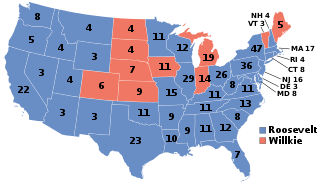
The 1940 United States presidential election was the 39th quadrennial presidential election. It was held on Tuesday, November 5, 1940. Incumbent Democratic President Franklin D. Roosevelt defeated Republican businessman Wendell Willkie to be reelected for an unprecedented third term in office. Until 1988, this was the last time in which the incumbent's party won three consecutive presidential elections.

The 1938 United States House of Representatives elections was an election for the United States House of Representatives were elections for the United States House of Representatives to elect members to serve in the 76th United States Congress. They were held for the most part on November 8, 1938, while Maine held theirs on September 12. They occurred in the middle of President Franklin D. Roosevelt's second term. Roosevelt's Democratic Party lost a net of 72 seats to the Republican Party, who also picked up seats from minor Progressive and Farmer–Labor Parties.
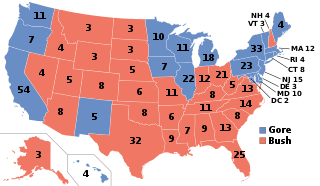
The 2000 United States elections were held on November 7, 2000. Republican Governor George W. Bush of Texas defeated Democratic Vice President Al Gore of Tennessee in the presidential election. Republicans retained control of both houses of Congress, giving the party unified control of Congress and the presidency for the first time since the 1954 elections.

The 1876 United States elections were held on November 7. In one of the most disputed presidential elections in American history, Republican Governor Rutherford B. Hayes of Ohio ended up winning despite Democratic Governor Samuel J. Tilden of New York earning a majority of the popular vote. The Republicans maintained their Senate majority and cut into the Democratic majority in the House.

The 1944 United States elections was held on November 7, 1944, during the final stages of World War II. President Franklin D. Roosevelt was easily re-elected to an unprecedented fourth term, and the Democratic Party retained their majorities in both chambers of Congress.

The 1956 United States elections were held on Tuesday, November 6, 1956. Incumbent Republican President Dwight D. Eisenhower won reelection in a landslide, while the Democrats retained control of Congress.

The 1984 United States elections was held on November 6, and elected the members of the 99th United States Congress. Republicans won a landslide victory in the presidential election, picked up seats in the House of Representatives, and successfully defended their Senate majority.

The 1972 United States elections were held on November 7, and elected the members of the 93rd United States Congress. The election took place during the later stages of the Vietnam War. The Republican Party won a landslide victory in the presidential election, and picked up seats in the House, but the Democratic Party easily retained control of Congress. This was the first election after the ratification of the 26th Amendment granted the right to vote to those aged 18–20.

The 1952 United States elections were held on November 4, 1952, during the Cold War and the Korean War. General of the Army Dwight D. Eisenhower won the White House in a landslide over Democratic Governor Adlai Stevenson of Illinois. Meanwhile, Republicans narrowly took control of both chambers of Congress, giving Republicans their first trifecta since the Great Depression. This is the last election until 2000 in which the Republicans held both chambers of Congress and the presidency at the same time. For the rest of the century, Republicans would often still win the presidency without full control of Congress.

The 1936 United States elections were held on November 3, 1936, during the Great Depression. Democratic President Franklin D. Roosevelt trounced Governor Alf Landon of Kansas in a landslide and the Democrats built on their majorities in both chambers of Congress.
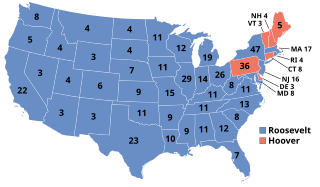
The 1932 United States elections were held on November 8, during the Great Depression. The presidential election coincided with U.S. Senate, U.S. House, and gubernatorial elections in several states. The election marked the end of the Fourth Party System and the start of the Fifth Party System. The election is widely considered to be a realigning election, and the newly established Democratic New Deal coalition experienced much more success than their predecessors had in the Fourth Party System.

The 1928 United States elections took place on November 6. In the last election before the start of the Great Depression, the Republican Party retained control of the presidency and bolstered their majority in both chambers of Congress.

The 1924 United States elections were held on November 4. The Republican Party retained control of the presidency and both chambers of Congress.
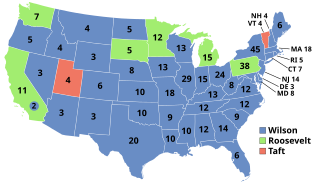
The 1912 United States elections elected the members of the 63rd United States Congress, occurring during the Fourth Party System. Amidst a division between incumbent Republican President William Howard Taft and former Republican President Theodore Roosevelt, the Democratic Party won the presidency and both chambers of Congress, the first time they accomplished that feat since the 1892 elections.

The 1904 United States elections elected the members of the 59th United States Congress. It occurred during the Fourth Party System. Republicans maintained control of the presidency and both houses of Congress. For the first time since the 1828 election, no third party or independent won a seat in Congress.
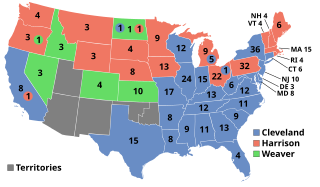
The 1892 United States elections was held on November 8, electing member to the 53rd United States Congress, taking place during the Third Party System. Democrats retained the House and won control of the presidency and the Senate. Following the election, Democrats controlled the presidency and a majority in both chambers of Congress for the first time since the 1858 elections.

The 1884 United States elections were held on November 4, electing the members of the 49th United States Congress. The election took place during the Third Party System. The Democratic Governor Grover Cleveland of New York defeated Republican Secretary of State James G. Blaine in the presidential election. In Congress, the Republicans retained control of the Senate while Democrats maintained control of the House of Representatives. This marks the last election in U.S. history in which the Democratic president came to office without unified control of Congress.
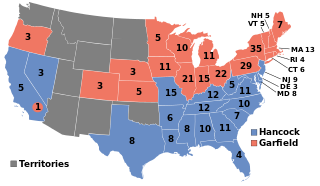
The 1880 United States elections occurred during the Third Party System, and elected the members of the 47th United States Congress. Republicans retained the presidency and took control of the House. An unclear partisan situation prevailed in the Senate. As the first presidential election after the end of Reconstruction, this election saw the first occurrence of the Democratic Party sweeping the Southern United States; the party would carry an overwhelming majority of Southern states well into the 20th century.

The 1856 United States elections elected the members of the 35th United States Congress and the President to serve from 1857 until 1861. The elections took place during a major national debate over slavery, with the issue of "Bleeding Kansas" taking center stage. Along with the 1854 elections, these elections occurred during the transitional period immediately preceding the Third Party System. Old party lines were broken; new party alignments along sectional lines were in the process of formation. The Republican Party absorbed the Northern anti-slavery representatives who had been elected in 1854 under the "Opposition Party" ticket as the second-most powerful party in Congress. Minnesota and Oregon joined the union before the next election, and elected their respective congressional delegations to the 35th Congress.

The 1848 United States elections elected the members of the 31st United States Congress and the 12th president of the United States. The election took place during the Second Party System, nine months after the Treaty of Guadalupe Hidalgo ended the Mexican–American War. With the issue of slavery dividing the nation, the Free Soil Party established itself as the third most powerful party in Congress. California joined the union before the next election, and elected its first Congressional delegation to the 31st Congress. Whigs won the presidency, but Democrats won a plurality in the House and retained control of the Senate.























